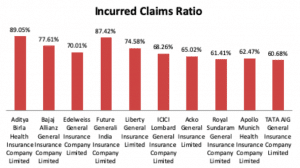Medical Claim Settlement Ratio of Top Companies for 2019 in India
 Health insurance policies have become the most essential part of everyone’s financial portfolios. Medical costs are rising unchecked and without a health insurance policy to pay for the bills, a medical contingency seems like a curse. When you have a health insurance policy you are assured of availing quality healthcare facilities as the policy promises to pay for the hospital bills which would incur. It, therefore, spares you the financial horror of a medical contingency and safeguards your savings.
Health insurance policies have become the most essential part of everyone’s financial portfolios. Medical costs are rising unchecked and without a health insurance policy to pay for the bills, a medical contingency seems like a curse. When you have a health insurance policy you are assured of availing quality healthcare facilities as the policy promises to pay for the hospital bills which would incur. It, therefore, spares you the financial horror of a medical contingency and safeguards your savings.
There are various health insurance companies in the market which offer some of the best policies with comprehensive coverage benefits. However, it is important to judge the claim settlement history of the company. Though health insurance policies promise settlement of your medical bills, if the company does not pay the claim, the policy would not fulfil its promise. That is why the claim settlement record of the company is required to be checked.
The Insurance Regulatory and Development Authority of India (IRDAI) publishes the Incurred Claims Ratio of health insurance companies after the end of every financial year. This report shows the claims paid by the company against its premium earnings. Let’s understand the concept of Incurred Claims Ratio in details –
What is Incurred Claims Ratio?
Incurred Claims Ratio is the ratio of the total amount of claims paid by an insurance company against the total amount of premiums earned. The formula for calculating the ratio is as follows –
Incurred Claims Ratio = (total amount of claims paid / total amount of premiums collected) * 100
Important aspects of the ratio
Here are some of the important features of Incurred Claims Ratio –
- The ratio is expressed as a percentage. It can be below 100% or even more than that.
- The ratio is calculated taking into consideration the number of claims paid and premiums collected in one financial year. So, if the ratio is for the financial year 2018-19, it would consider the claims paid and premiums collected between 1st April 2018 and 31st March 2019
- The ratio uses the amount of claim paid vis-à-vis premium collected. It does not represent the number of policies for which the claim was paid.
- The time taken in settling the claim is not considered in calculating the ratio
Interpreting the Incurred Claims Ratio
The Incurred Claims Ratio depicts the percentage of premium used by the insurance company to pay its claims. The ratio can, therefore, be depicted in the following ways –
- If the ratio is more than 100%, it shows the company is paying more in claims compared to the premiums collected. This shows that the company is making a loss and might face a problem in paying future claims.
- If the ratio is very low, i.e. between 20% and 50%, it shows that the company is earning high volumes of premiums but the claims are very less. This shows that the company is making too much profit. It might also show that the premiums charged by the company are very high which is resulting in a lower ratio. Alternatively, it might also show that the company has a very low claim experience.
- If the ratio is between 60% and 90%, it shows that the company is in a comfortable position to pay its claims. The premiums are not very high and allow the company to generate profits for sustainability. In fact, the ratio in this range is considered to be a good indicator of the company’s solvency.
Incurred Claims Ratio of different health insurance companies:
Here is a comparative analysis of the Incurred Claims Ratio of different health insurers for the financial year 2017-18–
| Name of the insurer | Incurred Claim Ratio |
| Acko General Insurance Limited | 65.02% |
| Aditya Birla Health Insurance Company Limited | 89.05% |
| Apollo Munich Health Insurance Company Limited | 62.47% |
| Bajaj Allianz General Insurance Company Limited | 77.61% |
| Bharti AXA General Insurance Company Limited | 98.50% |
| Cholamandalam MS General Insurance Company Limited | 39.96% |
| Manipal Cigna Health Insurance Company Limited | 46.29% |
| DHFL General Insurance Limited | 7.89% |
| Edelweiss General Insurance Company Limited | 70.01% |
| Future Generali India Insurance Company Limited | 87.42% |
| Go Digit General Insurance Limited | 60% |
| HDFC Ergo General Insurance Company Limited | 52.58% |
| ICICI Lombard General Insurance Company Limited | 68.26% |
| IFFCO Tokio General Insurance Company Limited | 90.69% |
| Kotak Mahindra General Insurance Company Limited | 48.21% |
| Liberty General Insurance Limited | 74.58% |
| Magma HDI General Insurance Company Limited | 34.93% |
| Max Bupa Health Insurance Company Limited | 50.19% |
| National Insurance Company Limited | 115.55% |
| Raheja QBE General Insurance Company Limited | 18.19% |
| Reliance General Insurance Company Limited | 106.54% |
| Religare Health Insurance Company Limited | 51.97% |
| Royal Sundaram General Insurance Company Limited | 61.41% |
| SBI General Insurance Company Limited | 52.93% |
| Shriram General Insurance Company Limited | 50.83% |
| Star Health & Allied Insurance Company Limited | 61.76% |
| TATA AIG General Insurance Company Limited | 60.68% |
| The New India Assurance Company Limited | 103.19% |
| The Oriental Insurance Company Limited | 113.86% |
| United India Insurance Company Limited | 110.95% |
| Universal Sompo General Insurance Company Limited | 104.17% |
Other important ratios:
Besides the Incurred Claims Ratio, here are some other important ratios which you should consider –
- Claim rejection ratio– this ratio measures the percentage of claims rejected by the insurance company against the total claims made on it. The ratio is calculated as follows:
- Claim rejection ratio =(number of claims rejected / total claims made) * 100
The ratio helps you check the history of claim rejection by an insurance company.
- Pending claim ratio– this ratio shows the number of claims which are pending with the insurance company at the end of the financial year. The formula is as follows-
- Pending claim ratio= (number of claims pending / total claims made) * 100
- Claim settlement ratio– this is an important ratio which is also advertised by health insurance companies. This ratio measures the number of claims settled by the insurer against the total number of claims made upon it. The calculation is done using the following formula-
- Claim settlement ratio= (number of claims settled / total claims made) * 100
All these ratios give an insight into the efficacy of handling claims by the insurance company. As such, before buying a health insurance policy, these ratios should be checked.
Incurred Claims Ratio (ICR) vis-à-vis Claim Settlement Ratio (CSR):
There is often confusion between the concepts of ICR and CSR. CSR is quite a popular concept which measures the number of claims settled by the insurance company. ICR, on the other hand, shows the financial capacity of the company to settle its claims.
Other differences between ICR and CSR include the following –
| Incurred Claims Ratio | Claim Settlement Ratio |
| The ratio is calculated for general insurance companies | The ratio is calculated for life insurance companies |
| The ratio uses monetary values of claims paid against premiums earned | The ratio uses absolute values of the number of claims paid against the total number of claims made |
Both these concepts are, therefore, different from one another. However, you should check both the ratios when finalising your health insurance policy.
Top health insurance companies in terms of Incurred Claim Ratio:
Here is a graph showing the top ten health insurance providers based on their ICR for the financial year 2017-18 –

How to choose the best health insurance policy?
To choose the best health insurance policy, the incurred claims ratio or the claim settlement ratio of the health insurance company should not be the sole parameter.
You should judge the policies on the following parameters too –
- The coverage offered – the wider the better
- The premium charged – the lower the better
- Sub-limits or limits on coverage features – as minimal as possible
- Waiting period for pre-existing illnesses – the lower the better
- Value-added benefits – the more the merrier
After comparing the plans on these parameters you should consider the ICR, CSR and other relevant ratios discussed above and then make your choice. When you make a well-researched choice of health plan, you would be rewarded with good coverage at affordable premiums. What’s more, your claims would also be settled quickly and smoothly. Isn’t that what you want?
MUST INSURANCE, kothrud is a client focused insurance agency which does Insurance Counselling / Advisory / Consultation to clients to first carry clients NEED ANALYSIS. Only post this stage, we recommend you a right insurance solution which we think is a MUST for your INSURANCE need.
MUST INSURANCE Kothrud, Pune, provides you insurance covering the following types: insurance companies in kothrud, health insurance companies in pune, best health insurance companies, best health insurance companies in india, insurance plans in india, claims settlement ratio, life insurance company in india, insurance companies in india is declared, companies in india is declared, list of top health insurance, latest irda claim settlement in Kothrud, medical insurance companies, claim settlement ratio of top, ratio is the number of claims, insurance company in india offering, settlement ratio of health insurance, settlement ratio of health insurance companies, top medical insurance companies, top best health insurance plans, best health insurance policy in india, current claim settlement kothrud, company holds claim settlement, company holds claim settlement ratio, list of top medical insurance companies, irda claim settlement ratio, insurers in the Netherlands, top health insurance companies, ratio of health insurance companies, general insurance companies
Contact us at: 8080496661
Facebook Page: https://www.facebook.com/HealthLifeVehicleGeneraralInsuranceLoansPunePCMC/?view_public_for=109514340630802
Courtesy Article : / September 20, 2019

